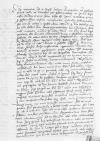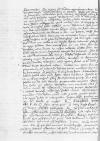Letter #355
Cornelis DE SCHEPPER to Ioannes DANTISCUSGenoa, 1527-06-27
English register:
De Schepper refers to his letter of June 3 from Monaco [IDL 349]. They decided to sail to Genoa from there, and not to travel to Vercelli through Piedmont, because of the increasing French incursions in this region, and the alliance between the Duke of Savoy [Charles III] and the King of France [Francis I], through the marriage of their infant children. Moreover, duke Antoniotto Adorno of Genoa sent four ships to transfer the Chancellor’s [Mercurino Gattinara's] company to Genoa. They embarked without delay on June 21, sailing in high seas at a distance from the Ligurian coast, because of the French threat. On June 23, they were attacked and pursued by French warships which they noticed too late. Their ships came under enemy fire as they tried to escape to Portofino, a port under Genovese rule. Most of the passengers and crew despaired of a favourable outcome, but the Chancellor, although suffering from podagra, and De Schepper remained confident. Eventually, the three triremes with the company of the Chancellor were able to escape, but the French captured a brigantine. As they approached Portofino, the French abandoned their pursuit because they came under fire from the fortress. The Genovese sent more triremes to escort the Chancellor's ships, keeping the French at a distance.
Despite the general optimism, De Schepper feels uncomfortable with the ignorance that surrounds him. De Schepper continues with a description of the situation in Italy, partly written in cipher. The situation is uncertain. There is a shortage of grain. Hostile sentiments against the Emperor [Charles V] and the Viceroy [Charles de Lannoy] prevail. The Chancellor is waiting for instructions from the Emperor. The imperial army is still in place. There are rumours that the King of England [Henry VIII] is mobilising troops. The Chancellor supports the restitution of Milan to Francesco Sforza. The situation remains unclear as long as there are no instructions from the Emperor. The imperial commander of Milan, Antonio de Leiva, assuming that the Chancellor left Spain against the wishes of the Emperor, sent troops to destroy the Chancellor's fiefs Sartirana and Valenza.
De Schepper discusses the treatment of the Bari question and inquires about the King of Denmark [Christian II], the Norwegian expedition and Melchior [Colditz]. The Duchy of Milan could be granted to the King of Bohemia [Ferdinand Habsburg], or its allocation could be postponed. Meanwhile, there will be a judicial inquiry into the case of Francesco Sforza.
De Schepper thinks Dantiscus feels lonely among the Spaniards, with so many companions having left. He hopes they will meet again in person. He asks Dantiscus to keep him informed. He himself will write as soon as he knows what line to take. He sends greetings to mutual friends, esp. to the Margrave [Johann Albrecht of Brandenburg-Ansbach], the nuntius Virginis, Vice-Chancellor [Baltasar Merklin von Waldkirch] and Dantiscus’ paramour [Isabel Delgada].
| received Valladolid, [1527]-07-08 Manuscript sources:
Auxiliary sources:
Early printed source materials:
Prints:
| ||||||||||||||||||||||||||||||||||
Text & apparatus & commentary Plain text Text & commentary Text & apparatus
Clarissimo Viro Domino
Salutem.
Ex
Navigavimus ergo et nocte illa diei 1527-06-21⌊XXI-i1527-06-21⌋ et die 1527-06-22⌊XXII-o toto1527-06-22⌋, 1527-06-23⌊XXIII-o1527-06-23⌋ autem, quae vigilia est divi 1527-06-24⌊Ioannis Babtistae1527-06-24⌋, sub hora diei orientis sextam, quae est apud nos fere XI-a, nescio qua negligentia, magna sane, sed eam nobis pepererat terrae amicae iam pridem conspectae vicinitas, prius fere in Gallicam classem incidimus, quam eam conspiceremuu(!)s. Subito itaque
Hic omnia dubia et intranquilla. Ingens adhaec penuria annonae.
Velim, me crebro certiorem facias de rebus tuis. Nam non dubito, quin tibi grave sit soli illic esse inter
Si advenerit illustrissimus dominus probably
Ex
Tibi addictissimus ut filius
[1 ] At the time Francis I had two daughters alive: Madeleine of France (1520-1537), and Margaret of France (1523-1574)
[14 ] Antonio de Leiva was commander in chief of the Imperial army in the Duchy of Milan from 1525 until 1535
[15 ] The Counties of Sartirana and Valenza had been granted in fief to Mercurino Arborio Gattinara by Francesco II Sforza in July 1522 as a reward for supporting Sforza’s interests. The donation was confirmed by Charles V in December of the same year (cf. cf. Rebecca Ard Boone, Mercurino di Gattinara and the Creation of the Spanish Empire, London-Brookfield-Vermont, Pickering&Chatto, 2014, series: Empires in Perspective 23, series ed.(s): Durba Ghosh , p. 97-98⌊ARD BOONEcf. Rebecca Ard Boone, Mercurino di Gattinara and the Creation of the Spanish Empire, London-Brookfield-Vermont, Pickering&Chatto, 2014, series: Empires in Perspective 23, series ed.(s): Durba Ghosh , p. 97-98⌋; BLACK, p. 184; Raccolta, p. 72 ss.)




